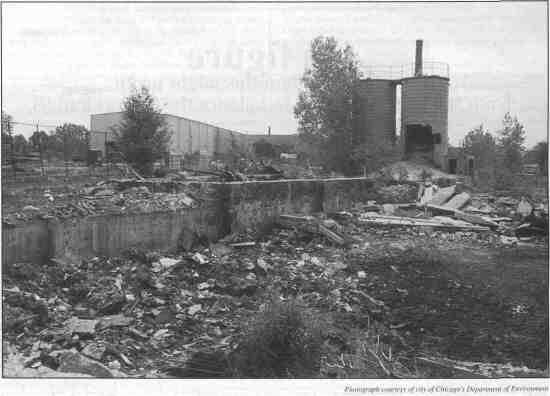By JENNIFER HALPERIN
Brownfields program lies fallow
Lack of greenbacks keeps a good idea from growingIt was an environmental official's nightmare: A company that was running a storage barn for buses and construction cranes on Chicago's West Side was using its warehouse as an indoor garbage dump. At first, city officials thought the building's worst pollution problem was the petroleum that was dripping from the old bus tanks. Then they learned that all kinds of junk had been accumulating, including 30 barrels of hazardous waste, construction debris and a broken-down truck. "Basically they were running an indoor landfill," says Ken Davis, who works in the city's environmental department. "They were taking tipping fees from people and taking in their waste. It took us a month to get all the garbage out." But in a classic case of turning lemons into lemonade, the city was able to clean up the pollution, then sell the property when the owner went bankrupt. A neighboring company, Scott Petersen Inc., which makes luncheon meats, needed new land to build a truck staging area next to its plant five miles west of the Loop. Without the additional space, the company would have had to leave Chicago. Instead, it invested $5.2 million in the old bus barn site, expanded its operations and hired 81 extra people. The project is touted as a model for "brownfields" programs Brownfield turned playing field? If northwest Indiana leaders have their way, the Chicago Bears could end up tossing the pigskin on a brownfield in Gary, 20 miles from the Loop. In mid-November, a group of business, political and community leaders unveiled plans for a $500 million project that includes a stadium for the team on a brownfield site near Gary Municipal Airport. The 74,000-seat open-air stadium would anchor a larger redevelopment project. An outdoor music theater, restaurants and an entertainment complex are among the attractions planned for the site, as well as parking for 20,000 to 30,000 cars. throughout Illinois and the rest of the country, says Geoff Sutton of the state's Environmental Protection Agency. Brownfields are abandoned industrial areas that have been contaminated by anything from dry-cleaning solvents to asbestos, but have the potential for redevelopment. Yet, making that kind of lemonade can be prohibitively expensive. While Chicago was able to budget some funds to recycle the bus barn site — and secured other dollars through federal grants — few communities have much cash for such projects. Gary King, an ERA expert on brownfields, says there are about 5,000 brownfield sites throughout Illinois located in large cities and tiny hamlets. But only 100 of these sites, which are considered polluted but don't pose a public health risk, have been cleaned up. Only another 300 are scheduled for cleanup. That's too bad, because there's a lot to like about the brownfields movement. Conservationists like it because it helps to preserve open land. "The concept of redeveloping former contaminated sites is a good one," says Virginia Scott of the Illinois Environmental Council, a nonprofit citizens' group. "It's something we have in general supported because it's a better alternative to [industrial] expansion into greenfields. The infrastructure, like roads and highways, is already there; you don't have to do more building." Municipal officials like it because it can help spur the return of much-desired factory jobs to an area. "Once industry leaves an area, it's gone forever," says Kevin Stanciel, an assistant to Chicago's environment commissioner. "With brownfields, we're trying to keep industry in a community, and in our pilot projects it's working. It's a tool for economic development in neighborhoods that really need it." Even industries should like it, because the cost of the brownfields program is based on future use. State EPA officials decide how clean the site needs to be; the requirements are less stringent, and less expensive, for future factories than for future playgrounds. But, as is often the case with popular, well-intentioned public policy, budget constraints keep the program from growing. A community can be considered lucky if it hosts a recycled 18/December 1995/Illmois Issues
brownfields site. In Moline, for example, the John Deere Co. cleaned up a polluted area where its workers built farm machinery for decades. The company then gave the land to the city, which built a $40 million civic center. Companies most often are motivated to clean their brown fields when they need clearance from the EPA to sell or donate their land. But, says the EPA's King, if companies can't afford or don't want to pay to clean their sites, they can let them sit idle. Since brownfields don't pose a public health threat, the state can't force unwilling owners to recycle their property. And because the state has limited resources for dealing with more serious pollution problems, brownfields sit at the bottom of a long list of potential cleanup projects. In the case of the Scott Petersen company, Chicago was lucky. The city was able to budget $210,000 to tear down the contaminated bus barn and clean the polluted lot. Not many cities would be able to foot such a bill. So the brownfields program remains a good idea slowly executed. Still, King says he can't get down about it. Even snail's-pace progress is better than none.
December 1995/Illinois Issues/19
|
|||||||||||||||
